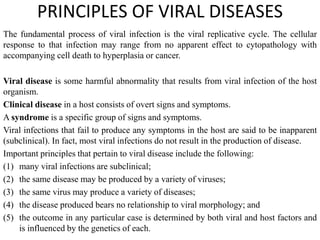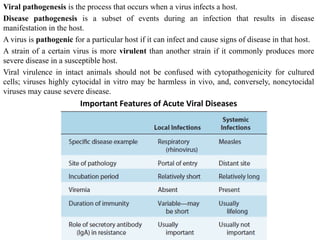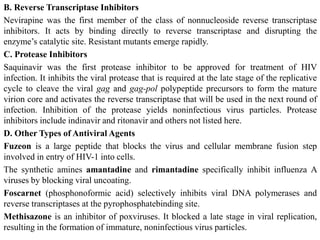Viral infections can range from asymptomatic to causing disease depending on the virus and host factors. Viruses typically enter the body through mucous membranes, then spread locally or systemically. Primary viral replication occurs at the entry site, followed by cellular injury, host immune response, and potential viral clearance or persistence. Disease results from a complex interplay between the virus infecting and damaging host cells, and the host response. The outcome of infection is determined by both viral virulence and host susceptibility.




![A. entry and Primary replication
For host infection to occur, a virus must first attach to and enter cells of one of the body
surfaces:
• skin,
• respiratory tract,
• gastrointestinal tract,
• urogenital tract, or
• conjunctiva.
Most viruses enter their hosts through the mucosa of the respiratory or gastrointestinal
tract. Major exceptions are those viruses that are introduced directly into the
bloodstream by needles (hepatitis B, human immunodefi ciency virus [HIV]), by blood
transfusions, or by insect vectors (arboviruses).
Viruses usually replicate at the primary site of entry. Some, such as influenza viruses
(respiratory infections) and noroviruses (gastrointestinal infections), produce disease at
the portal of entry and likely have no necessity for further systemic spread. They spread
locally over the epithelial surfaces, but there is no spread to distant sites.](https://image.slidesharecdn.com/9-231112090418-751c9487/85/9-Pathogenesis-and-Control-of-Viral-Diseases-pdf-5-320.jpg)

![B. Viral Spread and Cell Tropism
Many viruses produce disease at sites distant from their point of entry (eg,
enteroviruses, which enter through the gastrointestinal tract but may produce central
nervous system [CNS] disease).
After primary replication at the site of entry, these viruses then spread within the host.
Mechanisms of viral spread vary, but the most common route is via the bloodstream or
lymphatics. The presence of virus in the blood is called viremia.
Virions may be free in the plasma (eg, enteroviruses, togaviruses) or associated with
particular cell types (eg, measles virus). Some viruses even multiply within those cells.
The viremic phase is short in many viral infections.
In some instances, neuronal spread is involved; this is apparently how rabies virus
reaches the brain to cause disease and how herpes simplex virus moves to the ganglia to
initiate latent infections.](https://image.slidesharecdn.com/9-231112090418-751c9487/85/9-Pathogenesis-and-Control-of-Viral-Diseases-pdf-7-320.jpg)






















